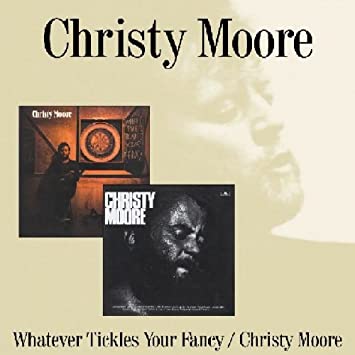 John Benninghouse wrote this review.
John Benninghouse wrote this review.
Christy Moore is an icon of Irish folk music. Growing up in the 1950s, he was surrounded by the music of his homeland, including such legends as the Clancy Brothers and Tommy Makem. After moving to England in 1966, Moore started down the path of the musician and was in various groups during the mid-to-late 1960s until he released his first solo album Paddy on the Road in 1969. This was followed by Prosperous in 1972, which he recorded with some old schoolmates. The experience went so well that they formed a band together: Planxty. The group achieved both commercial and critical success and is probably the best known Irish folk band of the time. However, Moore departed in early 1975 and returned to life as a solo musician. In April of that year he released Whatever Tickles Your Fancy, which he followed up with Christy Moore in 1976. These albums on re-release by Raven have been packaged together, and they give a snapshot of Moore getting back to his feet and establishing himself once again as a solo artist.
As his first post-Planxty statement, Whatever Tickles Your Fancy was a mixed bag. Fans and critics immediately warmed to the first side of the album, which saw Moore in classic fashion. A manic bodhran opens the traditional “Home by Bearna” and is joined by Moore’s voice and guitar which ably keep up. A couple of then-contemporary tunes follow. First are Dave Goulder’s “January Man” with its gentle picking and fatalistic lyrics and “The Moving-On Song (Go! Move! Shift!)” by Ewan McColl, which chronicles the lives of migrant workers. The latter features bouzouki and Kevin Burke’s yeoman fiddle work. Two more traditional songs follow: “Bunch of Thyme” and “Tippin’ It Up to Nancy.”
Side two begins with another Ewan McColl song, “The Ballad of Timothy Evans.” Moore’s brogue is familiar enough, but the drums and electric guitar must have been a shock for critics and fans alike in 1975. The songs here saw Moore moving from strictly traditional territory into that inhabited by the likes of Fairport Convention. The subject of “Timothy Evans” is falsely accused of murder and he pays the ultimate price. Fiddle and bass help provide some dramatic tension and, quite honestly, the song works very well as a piece of folk rock. The traditional ballad “Who Put the Blood” comes next with its slow-burning rhythm and aching fiddle. This is followed with a bit of an oddity in the form of a medley that includes a song by the American rock group Mountain, best known for “Mississippi Queen,” and a more conventional Irish dance song. “One Last Cold Kiss,” a tale of love between swans inspired by true events, has a certain swagger that, although good, seems woefully out of place here. It is paired with the fine “Trip to Roscoff” which is misplaced as part of the medley. The album closes with eight and a half minutes of “Van Diemen’s Land.” There’s some good acoustic guitar soloing at the end but it just lumbers along aimlessly for the rest of the time.
Moore must have taken the criticism to heart, as Christy Moore all but dropped the electric aspirations and there was nary a drum kit to be had. “The Dalesman’s Litany” dolefully describes the plight of workers in the wake of the Industrial Revolution. Some flourishes of electric guitar color the song but never get in the way of Moore’s acoustic work and voice. “Little Musgrave” in one form or another has been recorded by countless people and Moore’s version stands up with the best of them. It has a great small ensemble feel and his spirited singing here is a treat. However, his voice comes to the fore with the a cappella “Wave Up to the Shore.”
The dark tenor is put on pause, if only for a couple of songs, with the sprightly “Lanigan’s Ball” and “Johnny Jump Up,” which is also happens to be the name of a brand of cider. African drums appear on the otherwise traditionally performed “Limerick Rake,” while an American folk icon is conjured up for the finale. The album ends with Woody Guthrie’s “Sacco & Vanzetti,” originally recorded in the mid-1940s. The Italian names stick out but the lyrics bring back the plight of the working class and the music reminds the listener that the roots of much American folk music lies in the British Isles.
(Raven, 2004)
